Ards nclex - Study guides, Class notes & Summaries
Looking for the best study guides, study notes and summaries about Ards nclex? On this page you'll find 324 study documents about Ards nclex.
Page 4 out of 324 results
Sort by
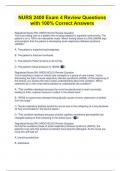
-
NURS 2400 Exam 4 Review Questions with 100% Correct Answers
- Exam (elaborations) • 18 pages • 2024
-
Available in package deal
-
- $10.99
- + learn more
Registered Nurse RN: ARDS NCLEX Review Question You're providing care to a patient who is being treated for aspiration pneumonia. The patient is on a 100% non-rebreather mask. Which finding below is a HALLMARK sign and symptom that the patient is developing acute respiratory distress syndrome (ARDS)? A. The patient is experiencing bradypnea. B. The patient is tired and confused. C. The patient's PaO2 remains at 45 mmHg. D. The patient's blood pressure is 180/96. C Registered Nurs...
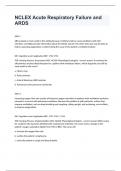
-
NCLEX Acute Respiratory Failure and ARDS questions with answers
- Exam (elaborations) • 11 pages • 2024
- Available in package deal
-
- $16.99
- + learn more
NCLEX Acute Respiratory Failure and ARDSANS: C ABG analysis is most useful in this setting because ventilatory failure causes problems with CO2 retention, and ABGs provide information about the PaCO2 and pH. The other tests also may be done to help in assessing oxygenation or determining the cause of the patient's ventilatory failure. DIF: Cognitive Level: Application REF: TOP: Nursing Process: Assessment MSC: NCLEX: Physiological Integrity - correct answer To evaluate the effectiveness ...
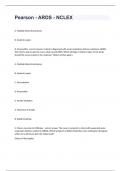
-
Pearson - ARDS - NCLEX questions and answers graded A+ passed
- Exam (elaborations) • 8 pages • 2024
- Available in package deal
-
- $12.99
- + learn more
Pearson - ARDS - NCLEXA. Multiple blood transfusions B. Systemic sepsis D. Pancreatitis - correct answer A client is diagnosed with acute respiratory distress syndrome (ARDS). The client's spouse asks the nurse what caused ARDS. Which etiology of indirect injury to the lungs should the nurse include in the response? (Select all that apply.) A. Multiple blood transfusions B. Systemic sepsis C. Fat embolism D. Pancreatitis E. Smoke inhalation A. Shortness of breath B. R...
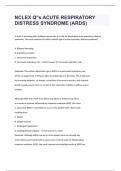
-
NCLEX Q"s ACUTE RESPIRATORY DISTRESS SYNDROME (ARDS) fully solved 2024
- Exam (elaborations) • 4 pages • 2024
- Available in package deal
-
- $10.49
- + learn more
NCLEX Q"s ACUTE RESPIRATORY DISTRESS SYNDROME (ARDS)A nurse is assessing with multiple trauma who is at risk for developing acute respiratory distress syndrome. The nurse assesses for which earliest sign of acute respiratory distress syndrome? A. Bilateral wheezing B. Inspiratory crackles C. intercostal retractions D. Increased respiratory rate - correct answer D. Increased respiratory rate Rationale: The earliest detectable sign of ARDS is an increased respiratory rate, which can beg...
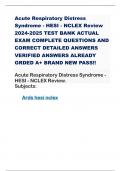
-
Acute Respiratory Distress Syndrome - HESI - NCLEX Review 2024-2025 TEST BANK ACTUAL EXAM COMPLETE QUESTIONS AND CORRECT DETAILED ANSWERS VERIFIED ANSWERS ALREADY GRDED A+ BRAND NEW PASS!! Acute Respiratory Distress Syndrome - HESI - NCLEX Review. Subject
- Exam (elaborations) • 7 pages • 2024
-
- $17.99
- + learn more
Acute Respiratory Distress Syndrome - HESI - NCLEX Review TEST BANK ACTUAL EXAM COMPLETE QUESTIONS AND CORRECT DETAILED ANSWERS VERIFIED ANSWERS ALREADY GRDED A+ BRAND NEW PASS!! Acute Respiratory Distress Syndrome - HESI - NCLEX Review. Subjects: Ards hesi nclex
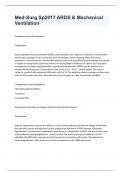
-
Med-Surg Sp2017 ARDS & Mechanical Ventilation questions and answers 2024
- Exam (elaborations) • 31 pages • 2024
- Available in package deal
-
- $17.99
- + learn more
Med-Surg Sp2017 ARDS & Mechanical Ventilation Unresponsive arterial hypoxemia Explanation: Acute respiratory distress syndrome (ARDS) can be thought of as a spectrum of disease, from its milder form (acute lung injury) to its most severe form of fulminate, life-threatening ARDS. This clinical syndrome is characterized by a severe inflammatory process causing diffuse alveolar damage that results in sudden and progressive pulmonary edema, increasing bilateral infiltrates on chest x-ray, hy...
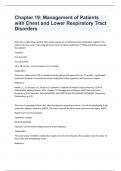
-
Chapter 19: Management of Patients with Chest and Lower Respiratory Tract Disorders fully solved 2024
- Exam (elaborations) • 63 pages • 2024
- Available in package deal
-
- $19.99
- + learn more
Chapter 19: Management of Patients with Chest and Lower Respiratory Tract DisordersThe nurse is educating a patient who will be started on an antituberculosis medication regimen. The patient asks the nurse, "How long will I have to be on these medications?" What should the nurse tell the patient? 3 months 3 to 5 months 6 to 12 months 13 to 18 months - correct answer 6 to 12 months Explanation: Pulmonary tuberculosis (TB) is treated primarily with anti-TB agents for 6 to 12 months. A prol...
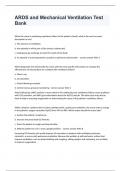
-
ARDS and Mechanical Ventilation Test Bank verified already passed
- Exam (elaborations) • 27 pages • 2024
- Available in package deal
-
- $17.99
- + learn more
ARDS and Mechanical Ventilation Test BankWhen the nurse is explaining respiratory failure to the patient's family, what is the most accurate description to use? a. The absence of ventilation. b. Any episode in which part of the airway is obstructed. c. Inadequate gas exchange to meet the needs of the body. d. An episode of acute hypoxemia caused by a pulmonary dysfunction. - correct answer ANS: C Which diagnostic test will provide the nurse with the most specific information to evaluate ...
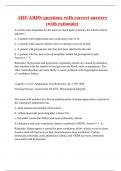
-
ARF/ARDS questions with correct answers (with rationale)
- Exam (elaborations) • 27 pages • 2024
-
- $12.99
- + learn more
It will be most important for the nurse to check pulse oximetry for which of these patients? a. A patient with emphysema and a respiratory rate of 16 b. A patient with massive obesity who is refusing to get out of bed c. A patient with pneumonia who has just been admitted to the unit d. A patient who has just received morphine sulfate for postoperative pain Answer C Rationale: Hypoxemia and hypoxemic respiratory failure are caused by disorders that interfere with the transfer of oxygen into...
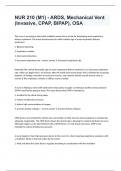
-
NUR 210 (M1) - ARDS, Mechanical Vent (Invasive, CPAP, BIPAP), OSA with complete solutions 2024
- Exam (elaborations) • 25 pages • 2024
- Available in package deal
-
- $17.99
- + learn more
NUR 210 (M1) - ARDS, Mechanical Vent (Invasive, CPAP, BIPAP), OSAThe nurse is assessing a client with multiple trauma who is at risk for developing acute respiratory distress syndrome. The nurse should assess for which earliest sign of acute respiratory distress syndrome? 1. Bilateral wheezing 2. Inspiratory crackles 3. Intercostal retractions 4. Increased respiratory rate - correct answer 4. Increased respiratory rate Rationale:The earliest detectable sign of acute respiratory distress s...

That summary you just bought made someone very happy. Also get paid weekly? Sell your study resources on Stuvia! Discover all about earning on Stuvia


